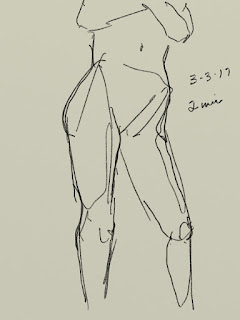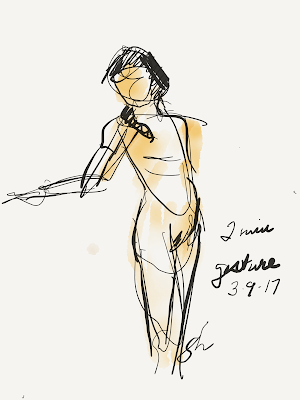Over the past few years I've experimented with an iPad for sketching, using various "dumb" styluses, most with blunt, spongy tips. The original idea with tablets was to use a finger as a marking device but the results were only okay at best, and many artists want to hold something--a stick of charcoal or a pencil or pastel stick, or a stylus with the right balance and feel. The styluses I tried in the past always felt clumsy. There was a lack of nuance and fine control. Furthermore, the iPad initially seemed intended to display content and make written notes, mostly, so the stylus wasn't all that important. The first iPad wasn't a very useful sketch device, at least in my hands, nor was an iPad Air. Part of the reason was that without pressure sensitivity in the tablet many effects available in traditional media could not be employed. You couldn't press harder with a brush tool, for example, and get a bigger spread of color into the image, nor could you readily vary line thickness when drawing. And the results looked far too artificial.
The problem of sensitivity has been solved during these past years with the emergence of pressure-sensitive styluses that transmit to the tablet via Bluetooth. Pressure changes are sensed and instantaneously transmitted. Not long ago I changed my tablet to an iPad Pro and added the Apple Pencil, which is a very smart stylus. The Apple Pencil is responsive and quick, with a narrow tip like a graphite pencil. With the apps I've tried so far the results have been gratifying to say the least. The iPad Pro/Pencil combo works very much like my desktop Wacom tablet. And like those devices, the pressure feedback in the pairing results in precisely the sorts of effects that were missing.
To try the new setup I took it to a figure drawing class that I direct at the Des Moines Art Center studios. Sessions traditionally begin with gesture drawings, which the students do with charcoal on big pads of newsprint. I made a few sketches during the quick poses using ArtRage5 (more on that program in another post) and the new iPad/Pencil duo.
 The great thing about this setup for me was how quickly it became unobtrusive--that is, how fast I was able to forget that I was using a computer tablet and simply sketch. The Pencil has the feel of a wooden pencil but with more heft, and its pressure sensitivity makes it easy to vary strokes from thin to thick to edged shading. And the ability to quickly shift to another screen made it possible to keep up with very quick poses--some as short as 20 seconds--without losing a step--no frantic flipping of pages, fumbling with charcoal, etc. The lines go down smoothly, with variation in darkness and thickness as pressure is applied, similar to traditional media. I set the program to have a middle value "sketch paper" surface and used a setting comparable to a 2B graphite stick. You could choose a "pastel" tool set to black and reproduce the appearance of charcoal very nicely as well. These are a couple of two minute poses I sketched during class.
The great thing about this setup for me was how quickly it became unobtrusive--that is, how fast I was able to forget that I was using a computer tablet and simply sketch. The Pencil has the feel of a wooden pencil but with more heft, and its pressure sensitivity makes it easy to vary strokes from thin to thick to edged shading. And the ability to quickly shift to another screen made it possible to keep up with very quick poses--some as short as 20 seconds--without losing a step--no frantic flipping of pages, fumbling with charcoal, etc. The lines go down smoothly, with variation in darkness and thickness as pressure is applied, similar to traditional media. I set the program to have a middle value "sketch paper" surface and used a setting comparable to a 2B graphite stick. You could choose a "pastel" tool set to black and reproduce the appearance of charcoal very nicely as well. These are a couple of two minute poses I sketched during class.  During that same figure class, while the students worked in charcoal I tried out other programs for sketching. One had used before on iPads was Paper, from Fifty Three which is designed to emulate notebooks and sketch paper, allowing the user to write notes plus add sketches, diagrams, and so on. For an artist it can function as a digital sketchbook, allowing you to set up separate notebooks for different topics, or particular time periods. The company markets a proprietary Bluetooth stylus (called simply The Pencil) which predated the Apple Pencil by several years but has a rather clunky shape like a flat carpenter's pencil.
During that same figure class, while the students worked in charcoal I tried out other programs for sketching. One had used before on iPads was Paper, from Fifty Three which is designed to emulate notebooks and sketch paper, allowing the user to write notes plus add sketches, diagrams, and so on. For an artist it can function as a digital sketchbook, allowing you to set up separate notebooks for different topics, or particular time periods. The company markets a proprietary Bluetooth stylus (called simply The Pencil) which predated the Apple Pencil by several years but has a rather clunky shape like a flat carpenter's pencil.With my new tablet and stylus, Paper functioned really well. I had used it with my previous incarnations of iPad, but even though it gives a good emulation of various media, from pencil to flexible-nib pen to watercolor, etc. it has never felt like a go-to app for me. Still, its simple interface makes for quick sketching, which is a real advantage when there is a need, as in gesture drawings. I did some gestures and other quick drawings with added color using a tool to emulate watercolor and a dip pen using India ink. Here are two.
The student stands at her drawing board, bent forward and studying the model intensely. She was intent and focused but only held the position for a few seconds at a time. Luckily, she continued to concentrate and returned to the spot enough times to allow a quick sketch.
My next foray with tablet and stylus will probably be to try sketching outdoors, either cityscapes or perhaps various landscape objects like trees, etc. For now, the two I've mentioned above are the programs I've most experience with. There are quite a few sketching applications available for both the Android and Apple operating systems that I've either never used or only now discovered. Some of them are Procreate, ASketch, Adobe Sketch, and Inkist. None is particularly expensive and some are free, so I will try out each and post an image or two as time goes by.


No comments:
Post a Comment